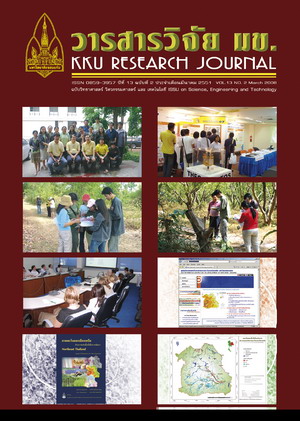Immobilized and characteristics of pyoverdin I onto modified micelle-templated silica (MTS) surface as a chelating agent.
Main Article Content
Abstract
A yellow-greenish biological product, pyoverdin I siderophore was produced from the Pseudomonas aeruginosa strain in modified SA medium and appeared as a blue fluorescent pigment under UV light. The
isolation of pyoverdin I was performed using an Amberlite XAD-16 resin and subsequently purified by CM
Sephadex C-25 and Bio-Gel P-2 column chromatography. The purity of pyoverdin I was investigated by
RP-HPLC with a gradient system (6-40% acetonitrile in 0.01 M acetate buffer, pH 6.0). In this work, the
optimum conditions for immobilization of pyoverdin I onto modified a micelle-templated silica (MTS)
surface were studied as a recyclable adsorbent material for removal of some heavy metals from aqueous
solution. The micelle-templated silica was chemically modified with 3-glycidoxypropyl-trimethoxysilane
(GPTMS) and then immobilized with pyoverdin I by forming a covalent bond between the amino group on the
peptide backbone and an epoxy group. The characteristics of pyoverdin I anchored onto the modified MTS
were investigated using fluorescence, infrared spectroscopy and scanning electron microscopy. Additionally,
the specific surface area of this material was calculated by the Brunaver, Emmett and Teller (BET) method
using nitrogen isotherm adsorption data. The surface area of commercial silica gel decreased from 609.2 to
405.4 m2.g-1, indicating that the pyoverdin I can be immobilized onto the surface of a silica solid support
before being used for further analysis.
isolation of pyoverdin I was performed using an Amberlite XAD-16 resin and subsequently purified by CM
Sephadex C-25 and Bio-Gel P-2 column chromatography. The purity of pyoverdin I was investigated by
RP-HPLC with a gradient system (6-40% acetonitrile in 0.01 M acetate buffer, pH 6.0). In this work, the
optimum conditions for immobilization of pyoverdin I onto modified a micelle-templated silica (MTS)
surface were studied as a recyclable adsorbent material for removal of some heavy metals from aqueous
solution. The micelle-templated silica was chemically modified with 3-glycidoxypropyl-trimethoxysilane
(GPTMS) and then immobilized with pyoverdin I by forming a covalent bond between the amino group on the
peptide backbone and an epoxy group. The characteristics of pyoverdin I anchored onto the modified MTS
were investigated using fluorescence, infrared spectroscopy and scanning electron microscopy. Additionally,
the specific surface area of this material was calculated by the Brunaver, Emmett and Teller (BET) method
using nitrogen isotherm adsorption data. The surface area of commercial silica gel decreased from 609.2 to
405.4 m2.g-1, indicating that the pyoverdin I can be immobilized onto the surface of a silica solid support
before being used for further analysis.
Article Details
How to Cite
Chamongkolpradit, W., Budzikiewicz, H., Chanthai, S., & Ruangviriyachai, C. (2017). Immobilized and characteristics of pyoverdin I onto modified micelle-templated silica (MTS) surface as a chelating agent. Asia-Pacific Journal of Science and Technology, 13(2), 182–196. retrieved from https://so01.tci-thaijo.org/index.php/APST/article/view/83721
Section
Research Articles
References
-


